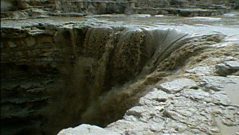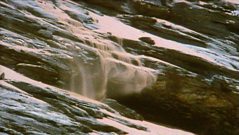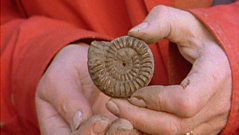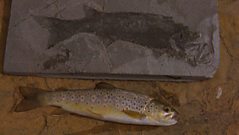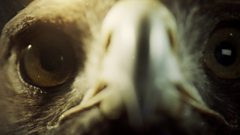
Stuff of life
Three billion year old marble on Iona was created ultimately by bacteria. This programme was first shown in 1997.
Warm surface water made the Earth a planet fit for life - single-celled bacteria in slimy films and filaments. Colonies of single cells grew large and hardened into limestone - the first of many layers in our crust. The first hint of that earliest type of life in Britain is to be found in the Hebrides, in a marble quarry on the island of Iona. This beautiful marble is nearly three billion years old: that's over half the age of the Earth itself. During that time it's been heated and squeezed. It started off as a limestone, but it's been changed beyond all recognition by being squashed and twisted in the collisions of ancient drifting continents - like pressure-cooked Play Doh! But limestone is the stuff of life. Though there's not a trace of living cells in there now, it must have been secreted by living algae on the shores of an ancient sea. There they built into their cells a lot of carbon dioxide and released oxygen. Like a giant lung, the oceans then began to work, absorbing carbon dioxide and releasing more of that oxygen. But while living cells thrived in the ocean, the land was bare. There was no vegetation, no soil to protect the land from the elements. Erosion was ferocious and the Hebrides was no excpetion. Laden with boulders and sand, the rivers laid down the rocks of the future. Even these tough, unyielding rocks were worn away, recycled and buried in their own debris. Over there, beyond the Hebrides of today, there once towered mountains as high as any Himalayas. From them swept rivers laden with sand, gravel, even boulders. They dumped their load in north-west Scotland and here on Iona. They're hardened to rock now, but otherwise pretty much unaltered - unlike the older contorted stuff.
Duration:
This clip is from
Featured in...
![]()
主播大秀 Nature
Be captivated, informed and inspired by the world's wildlife.
More clips from Postcards from the Past
-
![]()
The rise of land plants
Duration: 01:23
-
![]()
Britain's desert dunes
Duration: 01:27
-
![]()
Washed out
Duration: 02:11
-
![]()
Devonian fishing
Duration: 01:06
More clips from Natural World
-
![]()
Robo Hare Vs Golden Eagle—2019-2020, Super Powered Eagles
Duration: 02:41
-
![]()
Super Powered Eagles—2019-2020, Super Powered Eagles
Duration: 01:15
-
![]()
Meet Tilly the golden eagle—2019-2020, Super Powered Eagles
Duration: 02:01


